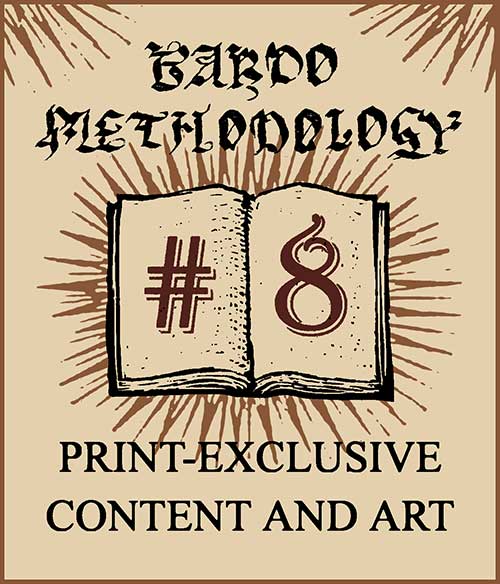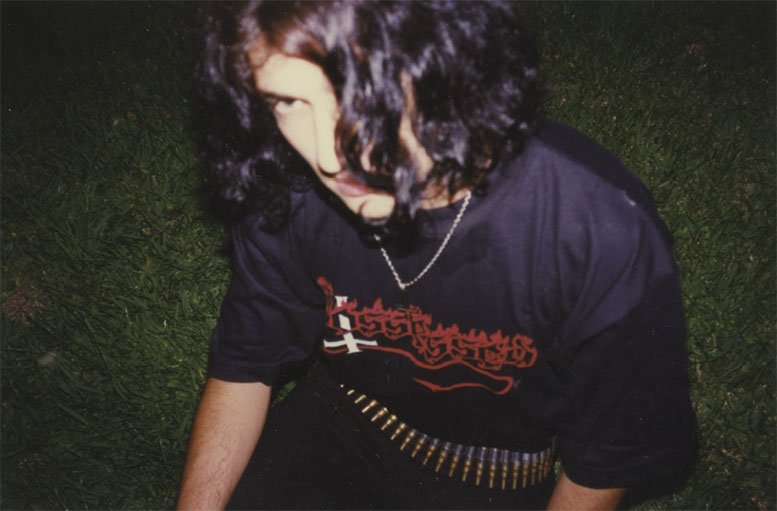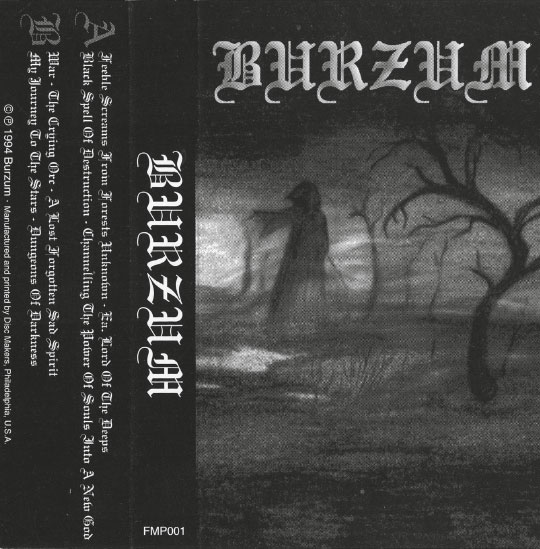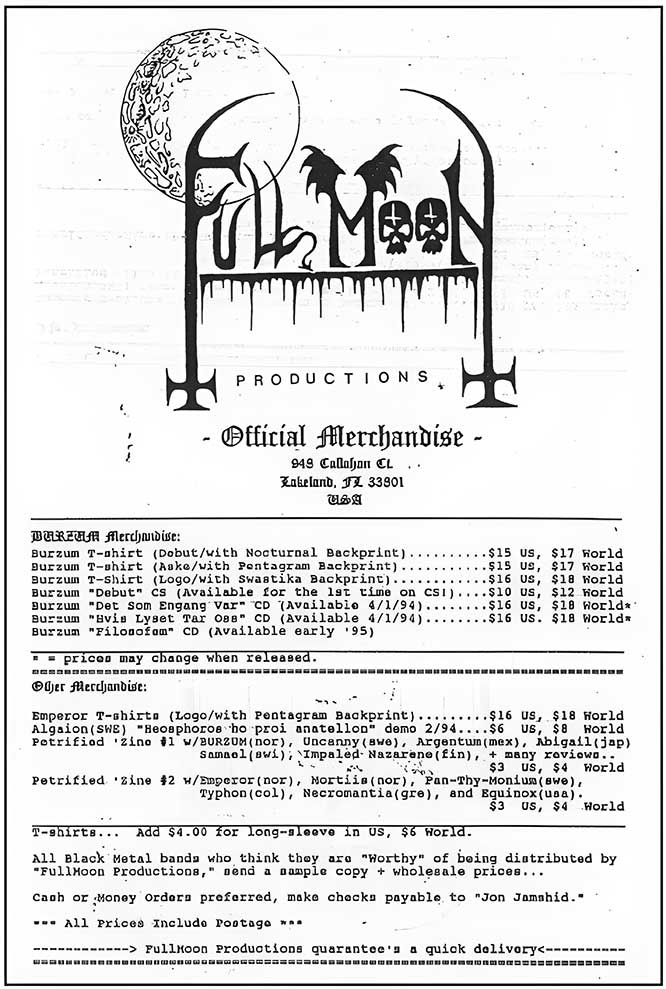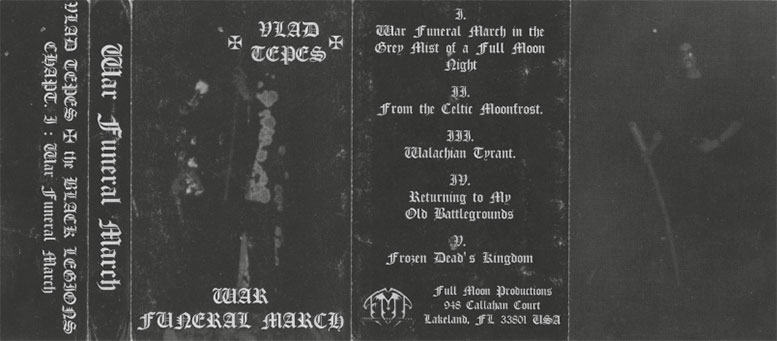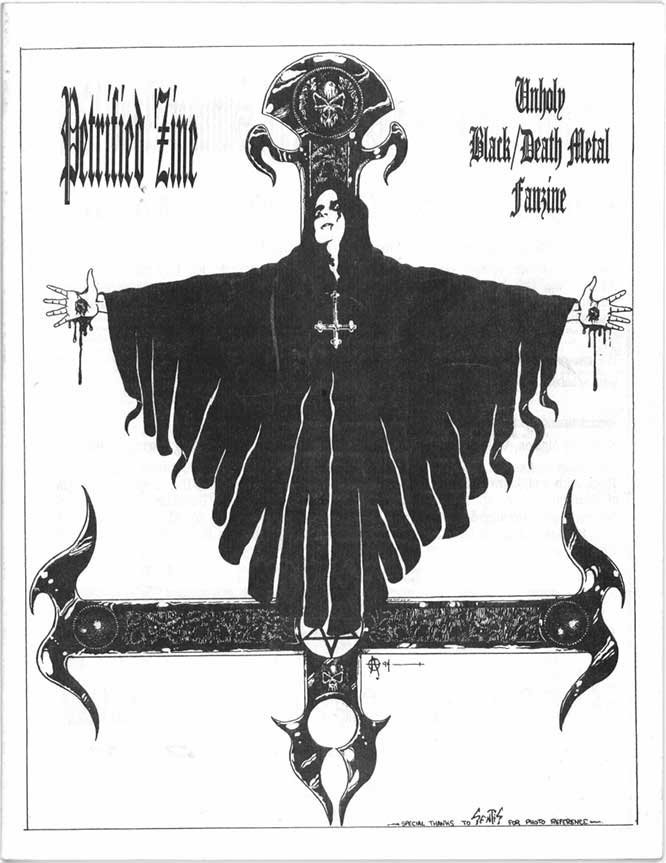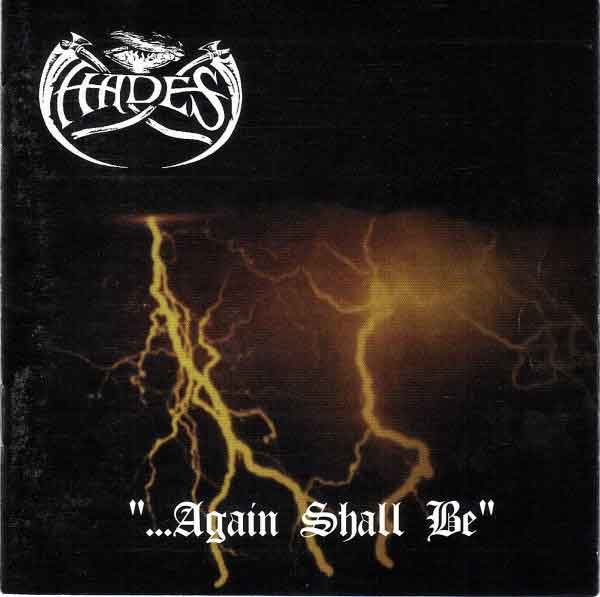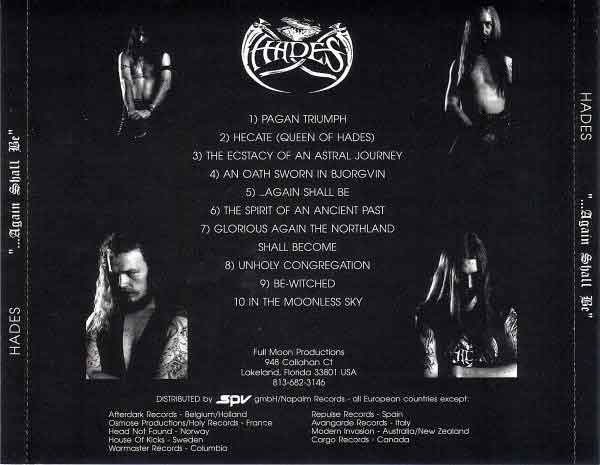Full Moon Productions III
2025-08-20
by Niklas Göransson
With fanzine earnings fuelling Full Moon Productions, Jon ‘Thorns’ Jamshid crossed from printed creed to recorded scripture. Vlad Tepes’ faltering march, Hades in Grieghallen, Algaion at Abyss – the fire of Petrified now burned through music.
JON JAMSHID: I used to buy tonnes of black metal at Ace’s Records in Tampa. When the IMMORTAL seven-inch, “A Blaze in the Northern Sky” (DARKTHRONE), and “The Oath of Black Blood” (BEHERIT) came out, I got them all from there. But once the genre exploded, Frank no longer carried many new releases.
With its demos, fanzines, and rare imports, Ace’s Records had served as a Jon’s portal into the broader metal underground. However, come 1993 – when French label Osmose Productions released albums like IMPALED NAZARENE’s “Tol Cormpt Norz Norz Norz…” and ROTTING CHRIST’s “Thy Mighty Contract” – Ace’s couldn’t keep up with the latest black metal titles.
JON: Independent record stores had to rely on distributors – and back then, there were barely any for black metal in the US. As a result, buying new releases meant ordering straight from Europe. Instead of just picking up my personal copies of each Osmose title, I figured, ‘Why not get twenty for wholesale prices and sell them through my distro?’
By the end of 1993, Jon had amassed a huge mailing list – all thanks to the success of his fanzine. Once the initial run of one hundred photocopied Petrified #2 sold out, Jon ordered a second batch from a newspaper printer, bringing the total pressing to roughly 12,000 copies.
JON: I don’t recall the exact number of contacts I had, but it was substantial. So, if I brought in twenty copies of the new IMPALED NAZARENE, I felt confident I could move them. That’s how I began ordering larger quantities – not just CDs, but demos and other imports as well.
In early 1994, FMP001 – the tape edition of BURZUM’s debut album – became the inaugural music release of Full Moon Productions. Notably, this was well over a year since Jon had secured the licensing agreement from the band’s driving force, Varg Vikernes.
JON: My initial thinking was, ‘Hey, I’m gonna release an album!’ and boom – it’s out. Not the case at all. First, I had to wait for Grishnackh (Vikernes) to send me the masters. And when the DAT tape finally arrived, I didn’t even know how to handle it… like, ‘What the fuck am I supposed to do with this?’
DAT – short for Digital Audio Tape – was a professional recording format widely used for mastering albums in the 1990s. Roughly the size of a compact cassette but requiring specialised equipment, bands and producers commonly delivered final mixes to labels this way.
JON: I had to drive to Tampa to find someone who could convert DAT into another format – probably CD, though I don’t remember exactly. I still have that original tape, by the way, stashed in one of my boxes. Then, the next step was figuring out who could manufacture cassettes.
Jon started asking bands where they got their tapes made, slowly gathering information. Eventually, he found a mainstream duplication company and placed an order.
JON: The cassettes looked good and sold out quickly – however, I got ripped off. They charged me around three or four dollars per tape, which was absurd at the time. It should’ve cost a buck, maybe less. But I didn’t know any better; I went with a big company and literally paid the price.
A recurring observation I’ve heard from label managers who began in the ‘90s is how daunting it was to learn the trade without any guidance. In today’s world, with all human knowledge a few keystrokes away, it’s easy to forget the complexities of information-gathering in the pre-Internet era.
JON: That was the toughest part, realistically. Back then, nobody helped you. No one offered advice, no guidebooks, no one said, ‘Go here, talk to this guy.’ I had to figure out each step of the way on my own. But once I got through my first release, everything moved much faster.
Meanwhile, when Wlad Drakksteim of French black metal band VLAD TEPES ordered one of F.M.P.’s BURZUM shirts, he included a tape titled “Rehearsal Winter ‘93”. Jon liked it enough to consider signing them.
JON: I mentioned my plans to Samoth from EMPEROR, but he wasn’t into the idea at all – said VLAD TEPES sounded too sloppy, even advised me against signing them. Nevertheless, the studio budget was only $800, which I sent over in the summer of ‘94.
That August, VLAD TEPES recorded five tracks, released by Full Moon Productions as the “War Funeral March” demo.
JON: Thing is, for my F.M.P. cassette, I’d asked them to record a few specific songs from that rehearsal tape. I still have the contract – three or four particular tracks were mutually agreed upon. But when I listened to the final result, not a single one we’d discussed was included.
Instead, all four songs from the rehearsal tape appeared on VLAD TEPES’ self-released demo “The Return of the Unweeping”, recorded the following month.
JON: They completely ignored our agreement. Naturally, I was fucking livid – but still decided to release the cassette. It bombed, of course; I doubt I even sold a hundred copies that first year. Honestly, I’ve always considered “War Funeral March” one of the weakest F.M.P. titles.
The year prior, Jon was sent “Alone Walkyng” – the demo of Norwegian black metal band HADES. On Christmas Eve 1992, six months before recording the demo, guitarist and vocalist Jørn Inge Tunsberg had burned Old Åsane Church alongside Varg Vikernes.
JON: When I first heard that demo, I thought, ‘This band is so fucking killer – I gotta reach out.’ So, I wrote them: ‘Hey, I’m starting a black metal label, just released BURZUM. Interested in signing?’ When they eventually said yes, it blew my mind. I mean, who the fuck was I?
Do you think Petrified laid the groundwork for that?
JON: Definitely. By then, the ‘zine had built enough credibility that people took me seriously. My reputation opened doors, even made the label possible. Moreover, the profits from Petrified #2 directly funded the HADES album, which became the first official F.M.P. release. I put the band in the studio and covered all their costs.
During the summer of 1994, just before Jørn was sentenced to two years in prison for arson, HADES recorded “…Again Shall Be” at Grieghallen, working with its legendary producer, Eirik ‘Pytten’ Hundvin.
JON: I didn’t know the band members very well and worried about getting ripped off, so I asked for Grieghallen’s contact details. The studio faxed me an invoice, and I wired the money straight to them. The budget totalled $8,000, which was a lot in 1994.
With that kind of investment, it must’ve been a bloody nervous wait to finally hear it.
JON: Well, yeah… but the final mix didn’t come on cassette or CD – I got it on DAT. So, despite holding the fucking thing in my hands, I couldn’t actually play it <laughs>. I had to send the masters to the CD plant, who mailed back sample discs. Of course, once I finally heard it, I was blown away.
Petrified #3 was published in November 1994. By then, the publication had levelled up – more interviews, improved aesthetics, and far wider reach. The cover artwork, courtesy of Will Lee, has since become iconic, eventually resurfacing on a KATHARSIS release.
JON: If I remember right, Will sent me that artwork. But interestingly, he recently mentioned it was based on a concept I provided – so maybe I suggested something and forgot? To be honest, I don’t recall. What I do know is I liked his piece so much I asked him to design the original F.M.P. logo as well.
I imagine Petrified had gained significant traction in the underground by then?
JON: Absolutely – the ‘zine had become a fixture in the black metal scene. Leading bands were approaching me instead of the other way around. After my EMPEROR interview in issue #2, Samoth even sent an advance copy of “In the Nightside Eclipse” specifically to ensure it got reviewed.
In addition to a review of EMPEROR’s 1994 debut album, Petrified #3 featured a candid interview with the band’s former drummer, Faust, who’d vacated his position after being sentenced for murder.
Once again, the review section is a time capsule. Jon’s positive assessment of the 1993 EVOL demo came as a pleasant surprise – I’d thought I was alone in liking them. Norway’s FLEURETY, somewhat of a punching bag at the time, are described as ‘above average’, though the notorious vocals are likened to ‘a prehistoric bird or maybe a very pissed-off chicken.’ The OPHTHALAMIA debut, on the other hand, receives glowing praise.
JON: I discovered countless killer records that way; the ‘zine definitely became a platform for new finds. Actually, a lot of bands weren’t even writing to Petrified directly anymore – they reached out to F.M.P. in hopes of getting signed. I’d listen to the material, and then sometimes either review or interview them.
Notably, nearly every band Full Moon Productions signed during those first few years had previously appeared in Petrified.
JON: Yeah, that makes sense. Whenever I received a tape from a band I’d never heard of and it blew me away, I’d immediately think, ‘How the hell aren’t these guys signed yet?’ Then, I would write them back and say, ‘Hey, I run a label – interested?’ To my surprise, only a handful declined.
Did you turn down anyone you later regretted?
JON: Regret might be pushing it, but I had a chance to sign DIMMU BORGIR. However, by that point, some newer Norwegian bands were adopting a broader image than I could support. After I passed on them, No Colours put out their debut. When I finally heard it, I was surprised – much better than I’d expected.
Keeping up with tradition, #3 was submitted to Metal Maniacs for review. This time, they acknowledged Petrified’s influence but reiterated their criticism of Jon’s willingness to platform controversial viewpoints.
JON: Yeah, the ideological angle made a lot of American magazines and distributors uncomfortable – they didn’t want to touch these bands. Labels like Relapse wouldn’t stock their material, and some ‘zines even refused to review anything linked to black metal.
Luckily, Jon had Petrified to promote his titles. The third issue featured interviews with all three bands on the F.M.P. roster: BURZUM, HADES, and VLAD TEPES.
However, following the publication of #3, relations between Full Moon Productions and VLAD TEPES soured. Unbeknownst to Jon, the Frenchmen didn’t want their demos reviewed – much less the band’s contact details printed.
JON: All of a sudden, these guys are threatening to murder me <laughs>. I told them, ‘Show up at my doorstep and you’re going back to France in body bags.’ After that, they gave an interview to a ‘zine called Kill Yourself, attacking me in print. Luckily, the editor was a friend of mine, so he offered me a rebuttal in the same issue.
Jon didn’t exactly consider losing VLAD TEPES a mortal blow to the label. One could safely say that “War Funeral March” was somewhat ahead of its time in terms of cult appeal.
JON: Sales were abysmal. Initially, I priced the tape at $8 – shipping included – but people complained. After I dropped it to $6, I sold another hundred copies; but even then, it didn’t do well. Eventually, I pulled “War Funeral March” from the catalogue altogether and let the remaining copies gather dust in my office.
Years later, VLAD TEPES and Les Légions Noires – the Black Legions, a loose network of like-minded bands and individuals from Brittany, France – gained international notoriety.
JON: There were claims circulating that they’d killed themselves and others, burned churches – all sorts of wild stories going around. These rumours sparked renewed interest in the tape, so I put it back up for sale and soon cleared out the rest.
Jon had far more success moving Petrified #3 – all one thousand copies were sold before they even arrived from the printer.
JON: Weirdly enough, I only did a single print run, and nothing after that – which turned out to be a mistake. I should’ve kept going; most people point to #3 as the best Petrified issue. But by then, F.M.P. had started overshadowing the ‘zine. Suddenly, I was running a label, putting out releases, improving distribution, and signing better bands.
In December 1994, the month after Petrified #3 came out, Full Moon Productions released FMP002: HADES’ debut album, “…Again Shall Be”.
JON: I only made five hundred copies of the BURZUM tape, but HADES was pressed in the thousands. This is the title that put F.M.P. on the map. Our first original production – not just a reissue – turned out to be a strong release. In my opinion, “…Again Shall Be” essentially made the label.
I bought this album – instant worship. From memory, it was the first time I heard such a masterful pairing of “Hammerheart”-era BATHORY with Scandinavian ‘90s black metal. In addition, knowing that an unrepentant church-burner created the music only amplified its impact.
JON: Yeah, like you said, HADES had a lot working in their favour when “…Again Shall Be” came out – amazing music made by revered scene personalities. The album sold really well and got nothing but great reviews. Actually, can I ask where you bought it from that early?
log in to keep reading
The second half of this article is reserved for subscribers of the Bardo Methodology online archive. To keep reading, sign up or log in below.

